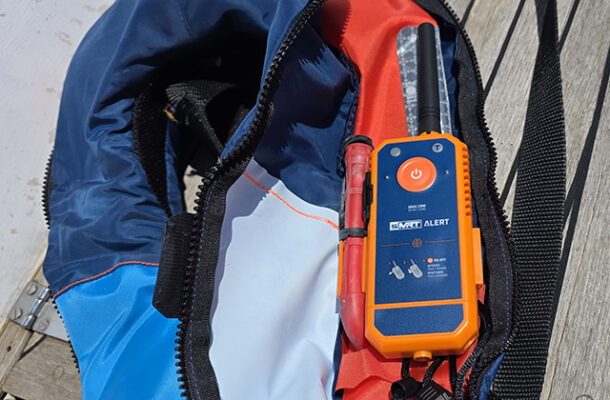I wear an AIS beacon every day as I move around Southampton and Solent. I commute by water in a busy shipping area. I wear the SMRT Alert beacon and here's why...
SMRT Alert AIS beacon – the beacon I wear every day
SMRT by name, smart by nature – Class M peace of mind afloat

When you spend half your life jumping from a tender to a boat in pitch dark, in the middle of Southampton Water, surrounded by container ships and pilot boats… you start to think a bit differently about personal safety.
Specifications:
- Type: AIS MOB Beacon (Class M Certified)
- Activation: Water immersion auto-activation + manual button
- Battery: Long-life sealed lithium, 7+ years
- Connectivity: NFC-enabled for battery/status checks via smartphone app
- Antenna: Rubberised, rugged design
- Size/Weight: Slightly larger than some, but robust and compact enough for most lifejackets
- DSC Capability: Yes (individual and group call options)
- Strobe light: Integrated high-visibility LED
- Waterproof Rating: IP68 (up to 10m)

I’ve been sailing double-handed or solo for many years now. It’s how I work and how I live. Which means the person most likely to save my backside if I fall in is probably already up to their elbows in mainsheet and confusion. So for their sake, not just mine, I wear an AIS beacon every time I step aboard.
The SMRT ALERT MOB Beacon is the latest piece of safety kit that’s earned a permanent place in my daily lifejacket, a Baltic Epiq. It’s the first to be certified Class M under the new rules (you know, the ones that say only proper, tested beacons can use AIS channels from Jan 2025 in Europe). That’s a big deal — it’s no longer just a fancy add-on. It’s a standard.
What’s it like in the real world? Solid. Chunkier than others, yes, but far simpler to operate — it auto-activates on water contact, no fiddly switches, no guesswork. The rubberised aerial feels rugged, not like some of the whippy plastic nonsense I’ve tested before. It slips comfortably into my everyday lifejacket, the one I wear when I’m ferrying kit back and forth to the boat in the RIB or tender. Doesn’t move, doesn’t jab me in the ribs.
Now, my Spinlock deckvest lifejacket? Yeah, not quite enough room in there — but that’s what belt pouches are for.
And the NFC check feature is really nifty. I just hold my phone on it, outside my lifejacket and up pops the battery status — no need to dig around or unzip anything.
This beacon doesn’t make me invincible. But it gives me the best chance of being seen, especially when I’m invisible to the big boats — and that’s all I can ask from a bit of tech.
If you move around at night in shipping zones, work/sail double-handed, or just want your name to ping up on every chartplotter in a half-mile radius when you hit the water — this beacon’s for you.
If the SMRT alert beacon doesn’t work for you, there’s other options available as I’ve outlined in my best beacons guide



